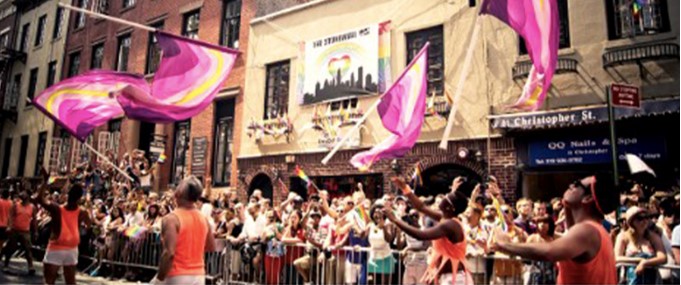
Imagine Credit: LPC
Released in honor of pride month, the story map features significant places like the Stonewall Inn. On June 16, 2022, the Landmarks Preservation Commission announced the launch of “Pride: Celebrating LGBTQ+ Landmarks”. This interactive story map highlights individual landmarks designated by LPC for their significant contributions to LGBTQ+ cultural and civil rights movements.
Now available online, the story map allows users to scroll through seven landmarks and easily learn about each location. Every landmark in the story map is illustrated with current and historic photographs, a summary of significance, and a link to the designation report, with the goal of educating the public on the city’s rich LGBTQ+ history.
The Stonewall Inn is one of the most important sites in LGBTQ+ history, with a police raid on June 28, 1969 leading to the five-day Stonewall Riots. This uprising began a new, more radical phase in the LGBTQ+ liberation movement, with unprecedented calls for “gay pride”. Within a few months of the Stonewall Riots, several activist organizations had formed in NYC and across the country. The first anniversary of the uprising was commemorated by the Christopher Street Liberation March, eventually growing into the month-long Pride celebrations we see today around the world.
The Gay Activists Alliance Firehouse, located at 99 Wooster Street in SoHo, served as GAA’s headquarters from 1971 to 1974. The Gay Activists Alliance formed in 1969 when members broke off from the Gay Liberation Front, and the organization’s sole purpose was advancing LGBTQ+ rights. While based at the Firehouse, GAA created their famous “zap” tactic of direct public confrontation with political figures. GAA also lobbied for local civil rights legislation in NYC, including the banning of police harassment and the repeal of sodomy laws.
The Women’s Liberation Center in Chelsea housed numerous lesbian and feminist organizations from 1972 to 1987, namely Lesbian Feminist Liberation. This organization was an early supporter of the City Council bill banning discrimination on the basis of sexual orientation. Activists at the Women’s Liberation Center joined together regardless of sexuality, providing community services and pushing for radical political action to benefit all women.
The Caffe Cino was located on Cornelia Street in Manhattan from 1958 to 1968 and owned by Joe Cino, an Italian-American gay man. The coffee shop, originally envisioned as an art exhibition space, is credited with being the first gay theater in NYC, launching the careers of “numerous significant gay artists”, and starting the Off-Off-Broadway theatre movement.
The Lesbian, Gay, Bisexual & Transgender Community Center, known more commonly today as The Center, moved into its current landmarked location in 1984. Historic organizations like GLAAD and ACT UP used The Center as their founding locations and primary meeting spaces. Today, The Center welcomes over 300,000 annual visitors and is used by 400+ community groups to host events and programs.
Lastly, the residences of authors James Baldwin and Audre Lorde are landmarked in Manhattan and Staten Island, respectively. Baldwin’s apartment at 137 W 71st Street was his permanent U.S. residence from 1966 until his death in 1987. While living there he participated in many NYC civil rights events and wrote important works like Tell Me How Long the Train’s Been Gone and If Beale Street Could Talk. Audre Lorde lived at 207 St. Paul’s Avenue from 1972 to 1987 with her partner, Frances Clayton, and her children. During that time, she rose to prominence for her political activism and produced works like Coal, The Cancer Journals, and Zami: A New Spelling of my Name.
As LPC continues to designate landmarks based on their importance to the city’s LGBTQ+ history, they will be added to the interactive story map.
Landmarks Chair Sarah Carroll spoke highly of the new story map, stating, “New York City’s diversity is its greatest strength, and in recent years LPC has been working to identify and designate sites that reflect the City’s rich history, including its LGBTQ+ history, so that we are telling the full story of all New Yorkers. The designated landmarks highlighted in this story map underscore New York City’s significant role in the fight for LGBTQ+ rights, and I hope it brings greater awareness to this important history.”
Mayor Eric Adams added: “LGBTQ+ history is New York City’s history, and we cannot truly appreciate where we are if we don’t know where we’ve been. These landmarks are meaningful sites in our collective story. As we celebrate Pride Month, I am excited that this new, interactive resource will allow all New Yorkers to recognize the LGBTQ+ community’s tremendous contributions to our city.”
Deputy Mayor for Economic and Workforce Development Maria Torres-Springer: “New York City has an especially rich and important history in the fight for LGBTQ+ rights. I’m proud to see these stories brought to light in even more ways in LPC’s interactive tools to increase awareness and education of such a significant piece of our city’s history.”
Citation: LPC Celebrates LGBTQ+ Landmarks with Story Map. June 16, 2022
By: Cassidy Strong (Cassidy is a CityLaw intern and a New York Law School student, Class of 2024.)

